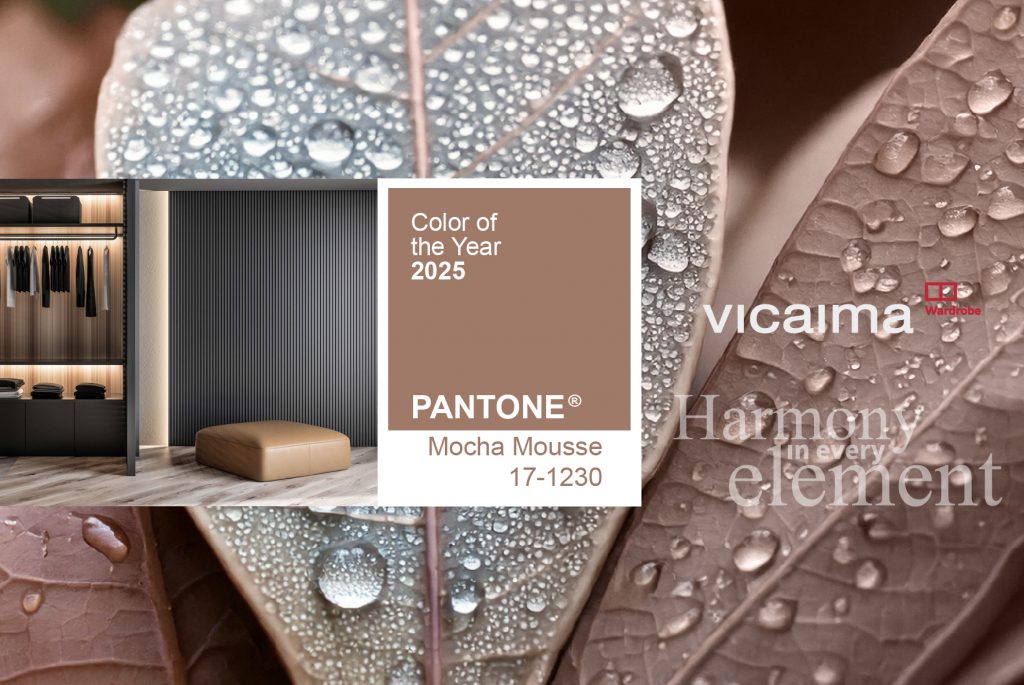Interior décor in change: five trends for 2025
Harmony, humanisation, sustainability and innovation: the main directions for the future of interior design, architecture and construction.

The arrival of 2025 brings with it a new vision for the architecture, construction and design sectors. Interiors will be extensions of our identities, where technology dissolves into aesthetics and harmony is the watchword.
From the visual alignment between doors and panels to personalisation inspired by a human touch, the year ahead promises significant steps forward in the environments we inhabit.
As one of Europe’s leading players in the design and production of doors, frames, wardrobes, panels and furniture pieces, Vicaima anticipates five trends that will make a difference in residential, hotel or commercial projects.
1. Full harmony in design, from doors to panelling
The perfect symbiosis between the elements of a space will be one of the key trends of 2025. Clean, visually fluid environments with a continuous design will define the concept of modernity in the near future.
It is in this context that Vicaima has invested in new cladding options, developed to respond to global trends and the needs of professionals. Available not only for doors, but also for wardrobes, panelling and pieces of furniture, these solutions enable cohesive and elegant spaces that breathe sophistication.
A scenario in which tones and textures take centre stage, responding to the demand for personalised and highly integrated designs. Pantone’s colour of the year, Mocha Mousse, is the perfect symbol of this trend. This warm tone, which evokes the naturalness of wood and organic materials, promises to stand out by adding a sense of interconnectedness, comfort and harmony to interiors.
2. A human touch to balance technological abundance
In an age where technology – especially Artificial Intelligence (AI) – plays a central role in customising and optimising processes, the balance between innovation and humanisation will be essential. The personalisation of spaces, as a response to the desire for welcoming environments, reflects the need for a human touch in the digital age.
In this way, the Vicaima Infinity line stands out for its ability to create fully customisable pieces that trace unique narratives. Each project becomes an expression of identity, offering solutions that meet the most specific needs of architects and designers.
On the other hand, AI will continue to drive the creation of decorative concepts, analysing patterns and preferences, combined with the sensitive eye of professionals. The future will thus be a fusion of technological precision and human creativity. Innovation promises to amplify the human touch and, by 2025, we will see more personalised spaces, where every detail reflects the style and history of the users.
AI will rise to prominence as a powerful tool to boost decorators’ creativity, with platforms that can analyse millions of images, styles and trends, helping professionals to overcome creative blocks and explore new ideas.
In a more concrete vision, the next innovations will consider the role of AI in boosting process optimisation and safety in the construction industry. By analysing data and identifying patterns, AI can be used to detect potential problems in equipment and safety systems, preventing failures and guaranteeing the safety of buildings.
Not limited to design and production, technology will also play a key role in the interaction between professionals and solutions. AI-based tools, such as the Vicaima 24/7 chatbot available in the UK (due to be extended to new markets in 2025), also provide simple and direct access to information about companies, their products, news or projects in an interactive way, as if it were a conversation.
2025 is therefore the ideal time for the industry to evolve as a whole in terms of digitalisation. Acting as a single industry, it will promote technological integration to increase efficiency, reduce waste and ensure that everyone is prepared for the challenges ahead.
3. Products that go beyond functionality
The growing demand for products that transcend their traditional function will be at the centre of next year’s trends. The case of integrated construction solutions, where smooth lines and high-quality materials coexist, reflects a clear preference for minimalist spaces that favour a balance between form and function.
This movement of visual continuity reinforces the importance of every detail in design, in which Portaro®, one of Vicaima’s most iconic brands, represents an essential element for elevating architectural environments, adapting to the most diverse concepts. In this sense, the doors will be increasingly integrated with the panelling and walls in total harmony, merging with the surrounding structures. The result is interiors that breathe lightness and sophistication, creating a unique visual sensation.
Other types of elements, such as wardrobes, will cease to be mere storage pieces and become central to the décor, contributing to the identity and aesthetics of the space in which they are located. The attention to detail and the sophistication of the materials will turn wardrobes into icons that blend harmoniously into any environment.
In 2025, we expect to see a focus on premium wardrobes, with exclusive accessories that enhance the user experience. In addition, other types of segments will also see a growing commitment to adding accessories that add value to solutions and add an ‘extra’ touch, making a difference to the impact of the décor.
Whether in the home or in different types of projects, these pieces play a fundamental role in creating elegant and highly functional spaces, contributing to the identity and exclusivity of interior projects.
4. Sustainable materials present, but with purpose
Sustainability will continue to be a fundamental pillar, but it will take on a stronger purpose. More than just an ecological choice, products and solutions that combine sophisticated design with a lower carbon footprint will be the natural choice for the most demanding challenges.
As far as doors are concerned, Portaro® solutions with thermal performance exemplify this trend, combining this feature with acoustic, fire and security performance. With a UD=1.2W/(m2.ºC), Portaro® Thermal achieves Classification A in terms of thermal transmission coefficient, guaranteeing excellent insulation and high energy performance, while offering a sophisticated design that integrates perfectly into any decorative space. It thus responds to the need to reduce energy consumption without compromising the comfort or quality of spaces – a performance that can also be found in other Vicaima options.
At the same time, the use of materials certified by organisations such as the FSC® (Forest Stewardship Council®) reinforces the commitment to environmentally responsible practices, ensuring that the elegance of the design reflects a positive impact on future generations.
As a whole, sustainability must dialogue with broader solutions. The use of green and innovative building materials is on the rise, with an increasing emphasis on materials that are renewable, recyclable or have a low environmental impact. While the higher initial cost of sustainable buildings may be a concern, this can be offset by lower lifecycle costs due to reduced energy consumption and maintenance.
In addition to wood and its contribution to decarbonisation, Vicaima has been on a path of positive transformation through a global sustainability policy, fully aligned with the United Nations (UN) Sustainable Development Goals (SDGs). The use of renewable energy sources, the recovery of waste and the implementation of digitalisation projects are part of a vast and diverse set of actions and partnerships aimed at achieving the established goals.
5. Innovative launches will be increasingly frequent
For a market that is constantly evolving, innovation will continue to be a driving force for change. The need for fast and efficient solutions drives the continued launch of products that respond to the modelling requirements of design and functionality.
The number of construction projects is also expected to increase in 2025, driven by factors such as population growth, urbanisation and the need for infrastructure development. Demand for housing, especially in urban areas, is expected to continue to rise, emphasising the need to respond to the housing deficit and the increased demand for more sustainable and affordable housing solutions.
Deloitte estimates that after closing 2024 with 10 per cent growth, the construction industry should continue to grow globally this year – albeit conditioned by interest rate fluctuations.
At the same time, the hotel sector is proving attractive to investors, with significant growth in projects geared towards luxury hospitality and sustainable tourism, driven by the recovery in global tourism. This trend is expected to continue into the new year, with the Global Travel Outlook 2025 estimating a global increase of 9 per cent in household budgets for travel.
In a world increasingly geared towards sustainability, personalisation and visual harmony, Vicaima is looking ahead to the new year by reaffirming its commitment to solutions that combine aesthetics and functionality. Whether in housing, hotels, commercial services, healthcare or schools, 2025 will be marked by unique, inspiring and future-proof environments.
